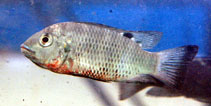| Family: |
Cichlidae (Cichlids), subfamily: Pseudocrenilabrinae |
| Max. size: |
22.5 cm TL (male/unsexed) |
| Environment: |
demersal; freshwater, non-migratory |
| Distribution: |
Africa: Bia, Tano and Pra Rivers (southeast Côte d'Ivoire and southwest Ghana) as well as in Lake Bosumtwi in Ghana (Ref. 53405). |
| Diagnosis: |
Dorsal spines (total): 14-16; Dorsal soft rays (total): 12-15; Anal spines: 3-3; Anal soft rays: 8-9. Diagnosis: lower pharyngeal bone about as long as broad, and with anterior lamella shorter than toothed area; median pharyngeal teeth not broadened; upper profile of head strongly convex; dorsal fin with 14-16 spines and 12-15 soft rays; flanks and belly whitish; head, back and flanks with irregular black spots; no bifurcated dark vertical bars on flanks; dorsal and anal without orange-red upper margin; caudal greyish to blackish (Ref. 53405).
Description: outer jaw teeth bicuspid and non-spatulate, inner jaw teeth and posterior pharyngeal teeth tricuspid; micro-gillrakers present; scales cycloid (Ref. 53405). Caudal fin truncate to moderately forked (Ref. 52307).
Coloration: ground colour whitish on sides and belly, yellowish-green on back; entire body, and in particular head, back and sides covered with irregular black spots; few bluish-green spots on occiput; belly sometimes blackish, with some red pigment; dorsal fin greyish-black, with some light oblique lines between spines, upper margin blackish and tip white-edged in large adults; "tilapian" spot has not been observed; pectoral fins transparent, pelvics and anal fin whitish to black; caudal fin greyish to black, sometimes spotted in central area, upper angle with a narrow edge in large adults (Lake Bosumtwi) (Ref. 53405). Black pattern unique to this species and not seen in congeners; when breeding, black pattern on body becomes more intense and breast turns bright red (Ref. 52307). |
| Biology: |
Mainly herbivorous, but also takes small amounts of crustaceans and insects (Ref. 52307). Oviparous (Ref. 205). Pair-bonding, open (Ref. 52307) substrate brooder/spawner, with both parents guarding the brood (Ref. 52307, 55659). Eggs are laid and incubated in nests (Ref. 55659). |
| IUCN Red List Status: |
Near Threatened (NT); Date assessed: 03 March 2020 (B1ab(iii)) Ref. (130435)
|
| Threat to humans: |
harmless |
| Country info: |
|
Source and more info: www.fishbase.org. For personal, classroom, and other internal use only. Not for publication.

